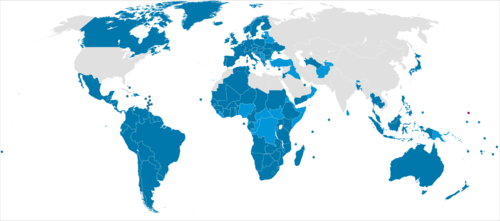Ottawa Treaty
 | |
| Type | treaty |
| Publication date | 18 September 1997 |
| Author(s) | |
| A treaty to ban land mines. | |
The Convention on the Prohibition of the Use, Stockpiling, Production and Transfer of Anti-Personnel Mines and on their Destruction, known informally as the Ottawa Treaty, the Anti-Personnel Mine Ban Convention, or often simply the Mine Ban Treaty, aims at eliminating anti-personnel landmines (AP-mines) around the world.
Parties to the Treaty
One state (the Marshall Islands) has signed but not ratified the treaty, while 32 UN states, including China, Russia, and the United States have not; making a total of 33 United Nations states not party.[1]
Overview
New types of ‘smart mines’ are being developed by signatories and non-signatories of the Ottawa Treaty. For example, in 2014, the United States (US) government announced a new US landmine policy. The objective of that policy is to ban the production and acquisition of antipersonnel mines (outside the Korean Peninsula), while increasing research on alternatives that technically comply with the Mine Ban Convention. The newly developed GATOR MINE SYSTEM, which is a network-based (the systems consists of more than 100 mines), automated weapons system is the first design of new landmines that are not restricted by the Ottawa Treaty.[2]
Furthermore, non-signatories to the Mine Ban Convention, like Russia, India, Iran, China, Saudi Arabia, and the US, are distributing or selling or giving their conventional ‘dumb’ landmines, often bought in third countries, to proxy forces (like the Free Syrian Army) and customers that are involved in several conflicts, for example in Yemen, Ukraine, Azerbaijan, Syria and Afghanistan.[3]